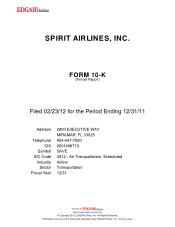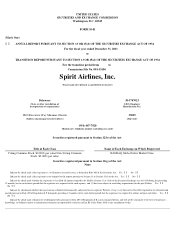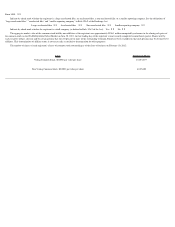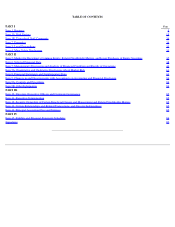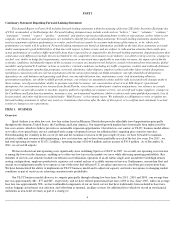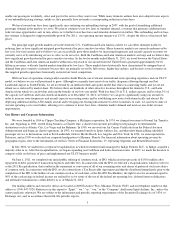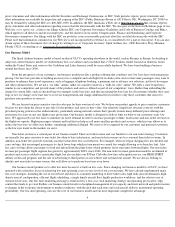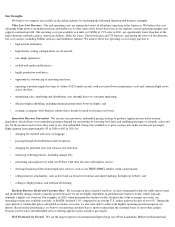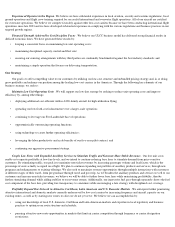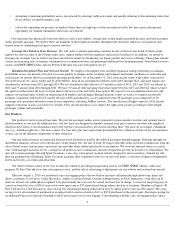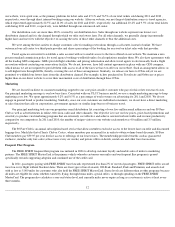Spirit Airlines 2011 Annual Report Download - page 6
Download and view the complete annual report
Please find page 6 of the 2011 Spirit Airlines annual report below. You can navigate through the pages in the report by either clicking on the pages listed below, or by using the keyword search tool below to find specific information within the annual report.
enable our passengers to identify, select and pay for the services they want to use. While many domestic airlines have also adopted some aspects
of our unbundled pricing strategy, unlike us, they generally have not made a corresponding reduction in base fares.
We have lowered our base fares significantly since initiating our unbundling strategy in 2007, with the goal of stimulating additional
passenger demand in the markets we serve. We plan to continue to use low fares to stimulate demand, a strategy that generates additional non-
ticket revenue opportunities and, in turn, allows us to further lower base fares and stimulate demand even further. This unbundling and low base
fare strategy is designed to support profitable growth. For 2011 , our operating income margin was 13.5% , despite the effects of increased fuel
prices.
Our principal target growth markets are in the domestic U.S., Caribbean and Latin America where we can either stimulate traffic by
reducing fares or have significant untapped growth potential for price-sensitive travelers. Many domestic markets are currently underserved by
low-cost, low-fare carriers and we believe we can successfully grow these markets by increasing frequencies and aircraft capacity on routes we
currently serve or by introducing service to cities we do not serve. Both the Caribbean and Latin American markets are large and we believe they
have significant growth potential for price-sensitive travelers. In the twelve months ended March 31, 2011, air travel between the United States
and the Caribbean and Latin American markets within non-stop reach of our aircraft from the United States generated approximately $13.8
billion in revenues, with only limited market stimulation by low fares. These markets have historically been characterized by untapped travel
demand from price-sensitive customers because they are primarily served by full-service, higher-fare airlines, and because several countries in
this targeted growth region have historically restricted air travel competition.
With our base of operations strategically located in South Florida, our overwater international route operating experience and our ULCC
model, we believe we are well positioned to grow. Although we currently have most of our traffic (frequency)flowing through our Fort
Lauderdale airport in South Florida, we are not bound by an inefficient hub-and-spoke-model that relies on connecting traffic and we are not
reliant on or enslaved by market share. We believe there are hundreds of other attractive locations throughout the domestic U.S., and Latin
America from which we can develop and reap the benefits of our low-cost model. With less than 2% of U.S. airline capacity and less than 3% of
the capacity in Caribbean and Latin American markets as of December 31, 2011, we believe we can grow significantly using our aircraft on
order to increase route frequencies and aircraft capacity on existing routes and by establishing new routes both domestically and abroad. By
deploying additional Airbus A320-family aircraft and leveraging our existing infrastructure to drive economies of scale, we can lower some of
our unit operating costs even further, allowing us to continue to lower base fares, stimulate market demand and increase non-ticket revenue
opportunities.
Our History and Corporate Information
We were founded in 1964 as Clipper Trucking Company, a Michigan corporation. In 1974, we changed our name to Ground Air Transfer,
Inc. and, beginning in 1983, started doing business as Charter One, a charter tour operator providing travel packages to entertainment
destinations such as Atlantic City, Las Vegas and the Bahamas. In 1990, we received our Air Carrier Certificate from the Federal Aviation
Administration and began air charter operations. In 1992, we renamed ourselves Spirit Airlines, Inc. and thereafter began adding scheduled
passenger service to destinations such as Fort Lauderdale, Detroit, Myrtle Beach, Los Angeles and New York. In 1994, we reincorporated in
Delaware, and in 1999 we relocated our corporate headquarters to Miramar, Florida. For financial information about operating revenue by
geographic region, refer to the information set forth in "Notes to Financial Statements- 19. Operating Segments and Related Disclosures".
In July 2006, we underwent a corporate recapitalization in which investment funds managed by Indigo Partners LLC, or Indigo, acquired a
majority stake in us. After this recapitalization, we began expanding our Caribbean and Latin American routes. In 2007, we made the decision to
compete solely on the basis of price and implemented our ULCC business model.
On June 1, 2011, we completed our initial public offering of common stock, or IPO, which raised net proceeds of $150.0 million after
repayment of debt, payment of transaction expenses and other fees. In connection with the IPO, we effected a recapitalization, which we refer to
as the 2011 Recapitalization, that resulted in the repayment or conversion of all of our remaining notes and shares of preferred stock into shares
of common stock. In connection with the IPO, we also entered into a Tax Receivable Agreement and thereby distributed immediately prior to the
completion of the IPO to the holders of our common stock as of such time, or the Pre-IPO Stockholders, the right to receive an amount equal to
90% of the cash savings in federal income tax realized by us by virtue of the use of the federal net operating loss, deferred interest deductions
and alternative minimum tax credits held by us as of March 31, 2011.
Our mailing address and executive offices are located at 2800 Executive Way, Miramar, Florida 33025, and our telephone number at that
address is (954) 447-7920. References in this report to “Spirit,” “we,” “us,” “our,” or the “Company” shall mean Spirit Airlines, Inc., unless the
context indicates otherwise. We are subject to the information and periodic reporting requirements of the Securities Exchange Act of 1934, or
Exchange Act, and, in accordance therewith, file periodic reports,
5

